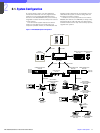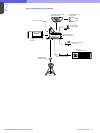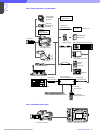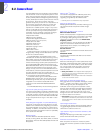
2
Chapter 2 Total System 18HDC-900/950/930 Series Product Information Manual
Wide variety of input and output connectors
• Optical connector
• HD SDI output connector
• DC power supply input connector
• Prompter signal output connector
• RCP connector
• VTR connector
• Lens connector
• Viewfinder connector
• Intercom connector
• Analog audio input connectors
• Tracker connector
• Test output connector
• Return control connector
• AC OUT connector
• Large lens connector
2-3. Camera Control Unit
The HDCU-900 Camera Control Unit carries out signal
processing and offers an interface for external
equipment. By incorporating a optical digital
transmission and digital control system, as well as
multiple inputs and outputs, the HDCU-900 provides
maximum camera performance combined with flexible
operation. It has been designed to achieve the highest
reliability, afford easy maintenance and allow flexible
system configuration.
The HDCU-900 features a down converter to convert
HD
*1
signals to SD
*2
, and a return video up converter
to convert SD signals to HD, making it usable with
standard definition color video cameras as well as
high-definition color video cameras. It can be
combined with an optional MSU-700A/750 Master
Setup Unit or an optional RCP-750/751/700/701
Remote Control Panel to form a camera control system
that meets your system needs. Furthermore, a system
capable of controlling multiple video cameras can also
be -configured - by adding a CNU-700/500 Camera
Command Network Unit.
*1 High Definition (HD) signal: A name for 1125-line high-
definition TV signals.
*2 Standard Definition (SD) signal: A name for NTSC/PAL,
525/625 component, or 525/625 composite signals.
The HDCU-950 Camera Control Unit is also
available for use with the HDC-950 and HDC-930
cameras. Its compact body and multiple video outputs
make this unit ideal for field use. A stand-alone system
can be easily configured by attaching the control
panel of the RM-B750 Remote Control Unit to the
HDCU-950, which allows you to directly operate the
connected camera from the HDCU-950.
The HDCU-900 and HDCU-950 camera control units
have the following major features:
Multiple video inputs and outputs (HDCU-900 only)
The HDCU-900 has four sets of HD-SDI (Serial Digital
Interface) signal inputs and outputs, and four sets of
SD component SDI signal inputs and outputs. Adding
of various optional function boards allows the following
signal input and output:
HKCU-901 SD Analog Interface board
This provides the capability of PAL, NTSC, and SD
analog component signal input and output.
HKCU-902 HD Analog Interface board
This provides HD analog signal input and output.
HKCU-903 Frame Rate Converter board
This provides 60i-/50i-format output in a 24P Cinema
Production system.
HKCU-904 Line Converter board
This provides 720/60P input and output.
Multiple video outputs (HDCU-950 only)
The HDCU-950 has three HD-SDI (Serial Digital
Interface) signal outputs (2 regular outputs and 1
monitor output) and two SD component SDI signal
outputs. Adding the optional units allows the following
signal outputs:
HKCU-951 SD Encoder board
This provides the capability of NTSC (or PAL) SD
analog component signal output.
HKCU-953 HD Frame Rate Converter board
This provides 60i-/50i-format HD and SD signal
outputs in a 24P Cinema Production system.
Three return video inputs (HDCU-950 only)
The HDCU-950 has three return video input
connectors, which receive either HD SDI, SD
component SDI or analog VBS signals (mixed input of
different signals is not allowed), may be set to 4:3 edge
crop, 16:9 squeeze, or letterbox.
External reference signals
The HDCU-900/950 family can be locked to an
external reference signal. Either an HD tri-level sync
signal or an SD sync (black burst) signal may be used
as the reference signal.
Internal down converter
When the system is operating at a 59.94/50 Hz field
frequency, HD signals can be converted to SD
component SDI signals using the down converter. The
output signal aspect ratio may be set to 4:3 edge crop,
16:9 squeeze, or letter box. The down converter has
independent image enhancement, gamma control,
and matrix ON/OFF features, and can be controlled
externally.
Internal up converter
The HDCU-900/950 family has an up converter to allow
monitoring of SD signal return video using an HD
viewfinder. The aspect ratio of the return video signal
may be set to 4:3 edge crop, 16:9 squeeze, or letter
box.
Optical digital transmission
The HDCU-900/950 can be connected to a camera
with the use of an optical fiber cable (two single-mode
optical fiber lines, two power lines, two control lines) for
the transmission of digitized video, audio, and control
signals. By connecting optical fiber cables, signals
can be transmitted up to a maximum of 3000 meters
(1.86 miles) when using the HDCU-900 and up to 1200
meters (0.7 mile) using the HDCU-950. The maximum
length of the cable supplying power to the camera
varies with the camera system configuration and with
the type of optical fiber cable.
Safety-oriented power supply
The HDCU-900/950 is designed for safety. When the
power is turned on, a low voltage is supplied at first.
Only after it has been verified that an appropriate
camera is attached, the normal 240 V power supply is
activated. The power is not supplied unless a camera
is connected via an optoelectric cable.
Also, the HDCU-900/950 is equipped with an alarm
indicator to warn of open or short circuits in the cable.


















